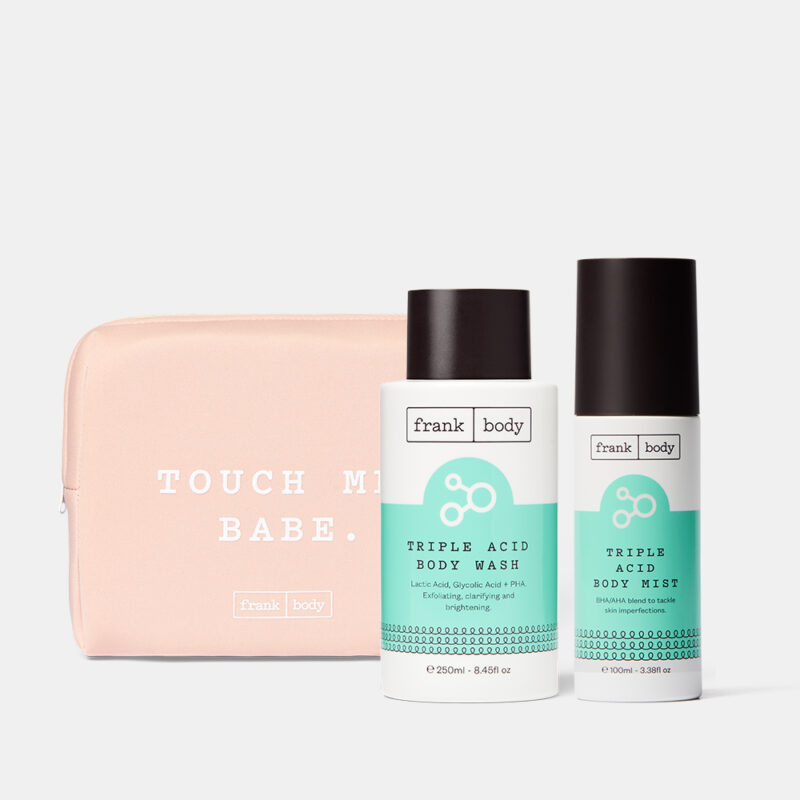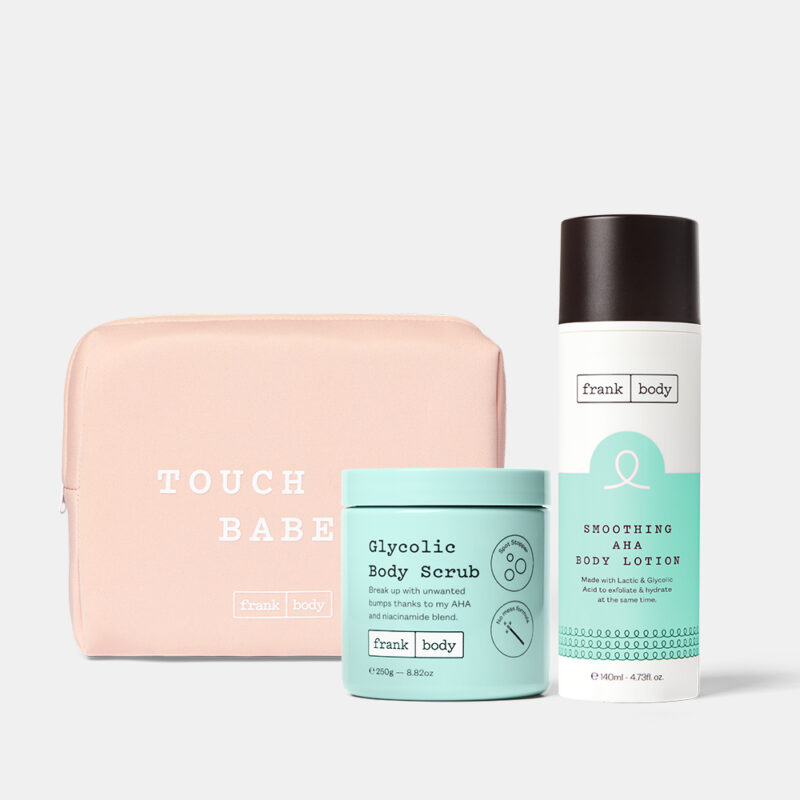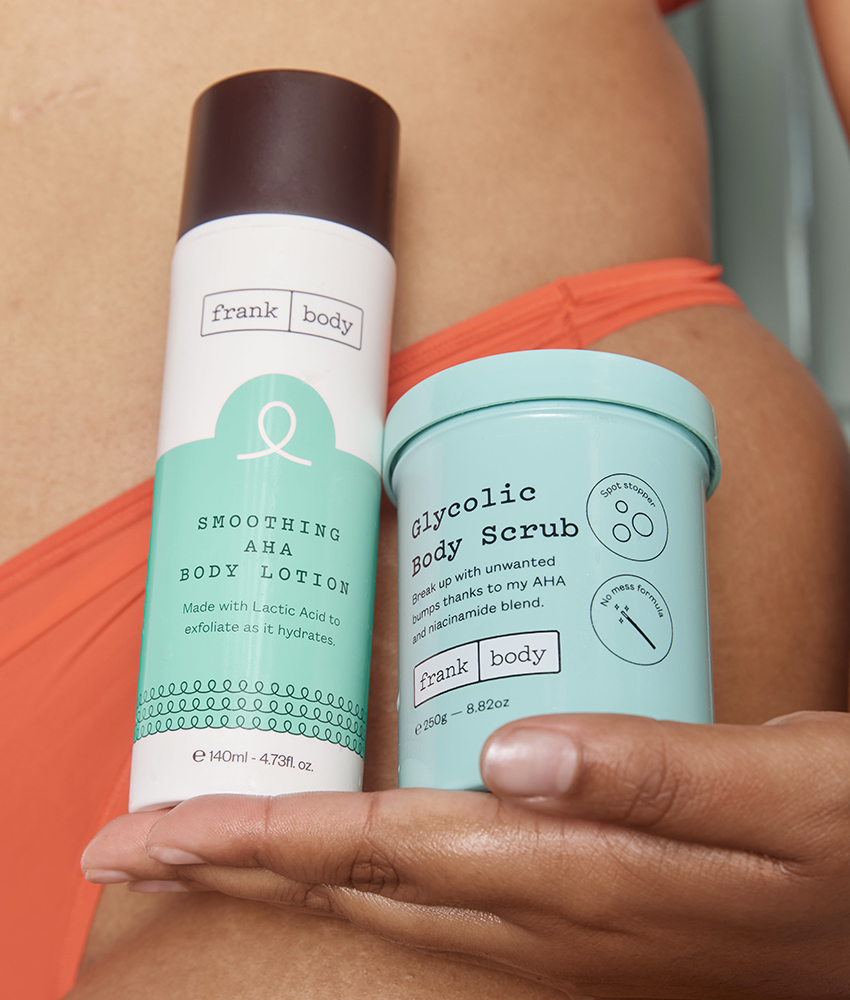My new Triple Acid Body Wash and Triple Acid Body Mist are packed with these acids. But how are they actually a body breakout treatment? Let’s see what these acids are all about.
GLYCOLIC ACID
Glycolic acid is a type of alpha hydroxy acid (AHA) derived from sugarcane. It’s widely used in skincare products because of its ability to exfoliate the skin, promote cell turnover, and improve the overall appearance and texture of the skin. How? So glad you asked.
Exfoliation:
Glycolic acid works by loosening the bonds between dead skin cells on the surface of the skin, making it easier for them to slough off. This process helps to reveal smoother, brighter skin underneath.
Stimulates collagen production:
Regular use of glycolic acid can stimulate collagen production in the skin. Collagen is a protein that helps keep the skin firm and youthful-looking, so increasing its production can lead to firmer, more elastic skin.
Improves skin texture:
By removing dead skin cells and promoting cell turnover, glycolic acid can help improve the texture of the skin, making it smoother and more even-toned. It can also help reduce the appearance of fine lines, wrinkles, and rough patches.
Unclogs pores:
Glycolic acid has the ability to penetrate deep into the pores, helping to dissolve and remove excess oil, dirt, and other impurities. This can help prevent clogged pores and reduce the occurrence of acne breakouts.
Brightens the complexion:
Regular use of glycolic acid can help fade dark spots, hyperpigmentation, and uneven skin tone, resulting in a brighter, more radiant complexion.
Enhances product absorption:
By exfoliating the skin and removing dead skin cells, glycolic acid can help enhance the penetration and effectiveness of other skincare products applied afterwards, such as moisturisers, serums, and treatments.
Suitable for most skin types:
Glycolic acid is generally well-tolerated by most skin types, including sensitive skin, although individuals with very sensitive skin may need to start with lower concentrations and gradually increase their tolerance.
However, it’s important to note that glycolic acid can increase the skin’s sensitivity to the sun, so it’s essential to use sunscreen daily when using products containing glycolic acid to protect the skin from sun damage. Additionally, some people may experience mild irritation or redness when first using glycolic acid, but this usually subsides as the skin adjusts to the product.
LACTIC ACID
Lactic acid and glycolic acid are both alpha hydroxy acids (AHAs) commonly used as a dynamic exfoliation duo, and the ability to improve the overall appearance and texture of the skin. While they share plenty of similarities, there are some key differences between the two:
Source:
Lactic acid is derived from lactose in milk, while glycolic acid is derived from sugarcane. This difference in the source does not significantly impact their effectiveness but may be relevant for individuals with specific allergies or sensitivities.
Exfoliating properties:
Both lactic acid and glycolic acid exfoliate the skin by loosening the bonds between dead skin cells, promoting their shedding and revealing smoother, brighter skin underneath. However, due to its larger molecular size, lactic acid exfoliates more gently and may be better suited for individuals with sensitive skin or those who are new to using AHAs.
Hydration:
Lactic acid has humectant properties, which is a fancy way of saying it can attract moisture to the skin. This makes it a good choice for individuals with dehydrated skin as it can help hydrate and plump the skin while exfoliating.
Hyperpigmentation:
Both lactic acid and glycolic acid can help fade dark spots, hyperpigmentation, and uneven skin tone. However, glycolic acid may be more effective for stubborn pigmentation due to its smaller molecular size and deeper penetration into the skin, but the combination of both is the sweet spot for cell turnover.
PHA / GLUCONOLACTONE
PHA stands for Polyhydroxy Acid, which is a type of chemical exfoliant. Like AHAs (Alpha Hydroxy Acids) and BHAs (Beta Hydroxy Acids), PHAs work by exfoliating the skin, promoting cell turnover, and improving skin texture and appearance. However, PHAs have some unique traits worth calling out.
Gentle exfoliation:
PHAs have larger molecular structures compared to AHAs and BHAs, which means they penetrate the skin more slowly and gently. This makes them suitable for individuals with sensitive skin who may experience irritation or redness from other types of chemical exfoliants.
Moisturising:
Unlike some other chemical exfoliants that can be drying to the skin, PHAs have humectant properties, meaning they attract and retain moisture in the skin. This makes them hydrating and can help improve the skin’s moisture barrier, making them perfect for dehydrated skin types.
Antioxidants:
PHAs have been found to have antioxidant properties, which can help protect the skin from free radical damage caused by environmental stressors such as UV radiation and pollution. This can help prevent premature aging and maintain overall skin health.
Anti-inflammatory:
PHAs can help calm and soothe irritated or inflamed skin. This makes a difference to conditions such as rosacea or eczema, as well as those with sensitive or reactive skin.
Enhances skin barrier function:
PHAs strengthen the skin’s natural moisture barrier, preventing moisture loss and maintaining optimal hydration levels. This can improve the overall health and resilience of the skin, making it more resistant to environmental stressors and less prone to sensitivity and irritation.
SALICYLIC ACID
Salicylic acid is a beta hydroxy acid (BHA) derived from willow bark or synthesised in a lab. It’s a powerhouse at penetrating the pores and exfoliating both the surface of the skin and within the pores themselves.
Unclogs pores:
Salicylic acid is oil-soluble, which means it can penetrate deep into the pores and dissolve the oil and debris that can clog them. By effectively unclogging pores, salicylic acid helps prevent and treat acne breakouts, including blackheads and whiteheads.
Exfoliates the skin:
Salicylic acid works by loosening the bonds between dead skin cells on the surface of the skin, promoting their shedding. This reveals smoother, clearer skin underneath and improves overall skin texture.
Calms inflammation:
Salicylic acid has anti-inflammatory properties, which can help reduce redness, swelling, and irritation associated with acne and other inflammatory skin conditions like rosacea.
Treats and prevents acne:
Salicylic acid is a key ingredient in many acne treatment products because of its ability to target multiple factors that contribute to acne formation, including clogged pores, inflammation, and excess oil production. It can be used to treat existing acne lesions and as a preventative measure to help reduce the occurrence of future breakouts.
Improves hyperpigmentation:
Salicylic acid can help fade dark spots and hyperpigmentation by promoting cell turnover and exfoliating the skin. This can result in a more even skin tone and a reduction in the appearance of post-inflammatory hyperpigmentation left behind by acne lesions.
Enhances product absorption:
Salicylic acid can help enhance the penetration of other skincare ingredients, such as moisturisers, serums, and treatments, by exfoliating the skin and removing dead skin cells.




